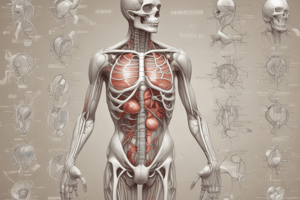Podcast
Questions and Answers
What does anatomy primarily study?
What does anatomy primarily study?
- Life processes
- Chemical reactions
- Body functions
- Structure of the body (correct)
Which of the following levels of organization is considered the basic unit of life?
Which of the following levels of organization is considered the basic unit of life?
- Organ
- Cellular (correct)
- System
- Tissue
What is the main function of a feedback system in the human body?
What is the main function of a feedback system in the human body?
- To regulate homeostasis (correct)
- To eliminate metabolic waste
- To facilitate movement
- To generate energy
Which body cavity is divided into regions and quadrants for better identification of organs?
Which body cavity is divided into regions and quadrants for better identification of organs?
What type of feedback system enhances or increases the intensity of a process?
What type of feedback system enhances or increases the intensity of a process?
Which of the following correctly describes the term 'physiology'?
Which of the following correctly describes the term 'physiology'?
What are the four basic types of tissue in the human body?
What are the four basic types of tissue in the human body?
Which of the following describes the process of reproduction in living organisms?
Which of the following describes the process of reproduction in living organisms?
What is the primary goal of homeostasis?
What is the primary goal of homeostasis?
Which component of a homeostatic mechanism recognizes changes in a controlled variable?
Which component of a homeostatic mechanism recognizes changes in a controlled variable?
What type of feedback system is most commonly associated with homeostasis?
What type of feedback system is most commonly associated with homeostasis?
What does a positive feedback system do in the context of homeostasis?
What does a positive feedback system do in the context of homeostasis?
Which of the following factors is NOT considered a variable maintained in homeostasis?
Which of the following factors is NOT considered a variable maintained in homeostasis?
What significant effect does aging have on homeostasis?
What significant effect does aging have on homeostasis?
Which term describes observable changes that can be measured in a patient?
Which term describes observable changes that can be measured in a patient?
What is the purpose of an autopsy?
What is the purpose of an autopsy?
Flashcards are hidden until you start studying
Study Notes
Learning Outcomes
- Define anatomy (study of structure) and physiology (study of functions).
- Describe structural organization of the human body, including levels from chemical to organism.
- Identify body systems and their interrelations.
- Explain homeostasis as a stable internal environment and its significance.
- Outline components of a feedback system and differentiate between negative and positive feedback.
- Distinguish between symptoms (subjective changes) and signs (observable changes) of diseases.
- Describe anatomical position and define directional terms and anatomical planes.
- Identify major body regions and their common names linked to anatomical terms.
- Explain segmentation of the abdominopelvic cavity into regions and quadrants.
Levels of Organization
- Chemical Level: Atoms combine to form molecules.
- Cellular Level: Cells, the basic units of life, containing organelles.
- Tissue Level: Groups of cells and their surrounding materials; four types: epithelial, connective, muscular, nervous.
- Organ Level: Groups of tissues performing specific functions.
- System Level: Groups of organs working together for common functions.
- Organism Level: Totality of all body systems in an individual.
Life Processes
- Key life processes include metabolism, responsiveness, movement, growth, differentiation, and reproduction.
Homeostasis
- Defined as maintaining a stable internal environment despite external changes.
- Involves dynamic adjustments of factors like temperature, blood pressure, and nutrient levels.
- Regulated by feedback systems that detect and respond to changes.
Homeostatic Mechanisms
- Stimulus: Disrupts controlled variables.
- Receptor: Detects changes and transmits input to the control center.
- Control Center: Processes input and sends output to effectors.
- Effector: Attempts to restore the normal state of altered variables.
Feedback Systems
- Negative Feedback: Predominant type; reverses changes in controlled variables back to normal (e.g., lowering high blood pressure).
- Positive Feedback: Rare; amplifies changes until stopped by an external factor (e.g., childbirth contractions and hormonal ovulation control).
Aging and Homeostasis
- Aging results in decreased ability to maintain homeostasis across all body systems.
- Healthy lifestyle practices can mitigate the effects of aging on homeostatic functions.
Clinical Terms
- Disorder: Abnormality in structure or function.
- Disease: Specific medical condition characterized by notable signs and symptoms.
- Symptoms: Subjective experiences not visible externally (e.g., pain, nausea).
- Signs: Objective indicators that can be measured (e.g., fever, high blood pressure).
Autopsy
- Procedure involving the examination and dissection of a body to determine the cause of death when normal life processes fail.
Studying That Suits You
Use AI to generate personalized quizzes and flashcards to suit your learning preferences.




